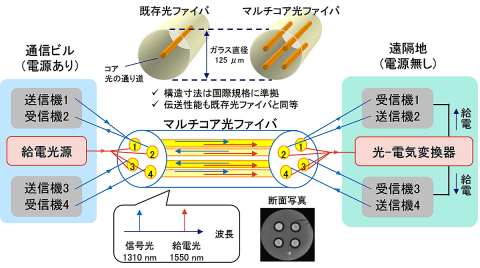Single Fiber Optic Cable Carries Power, Data Over 10 KM
Sending data costs power, so why not have some of it be usable at the destination point?

Researchers with the Nippon Telegraph and Telephone Corporation (NTT) and the Hokkaido National University Organization Kitami Institute of Technology have succeeded in breaking the record for the longest-distance power delivery through a single fiber optics cable. Previously only achieved for a distance up to two kilometers (due to optical intensity limits within the fiber itself), the results open up venues for disaster relief/recovery and power delivery in remote locations without the need for complex electrical infrastructure to be built (or rebuilt). The researchers managed to deliver in excess of 1 W (in addition to the high-speed data exchange allowed by fiber optics) across a 10km distance.
The feat makes use of NTT's multicore optical fiber (MCF) — a technology that keeps compatibility with existing fiber optics infrastructure through its standard glass diameter of 125 μm. But due to it being multi-core (meaning that there are a number of individual optical strands within the standard glass), each of these cores can be leveraged for their own purpose. In order to maximize power delivery, however, using multiple cores for power transmission may be required.

That's exactly what the research team did, however. The scientists pushed a light source with a wavelength of 1,550 nm into all four optical cores. For data transmission, two of the cores were injected with an additional wavelength around 1,310 nm, where both downlink and uplink data (with a transmission speed of 10 Gbps) could piggyback on. In the end, the researchers managed to send approximately 1 W of power across a 14 kilometer distance, achieving a world-record 14 W/km for their optical power supply system.
There's been a number of advances in photonics technology in the last few years, and this particular research now enables long-range energy delivery while also enabling wired communications. It's an incredibly simple and cost-effective solution for low-power delivery across distances and lacking electrical infrastructure, and one that's sure to see applications in the future.
Get Tom's Hardware's best news and in-depth reviews, straight to your inbox.

Francisco Pires is a freelance news writer for Tom's Hardware with a soft side for quantum computing.
-
Diogene7 Just for brainstorming purposes, in theory, could it be possible to technically possible to engineer the fiber optics in a way to deliver 240W DC power at 100m / 1km distances (while still keeping Tbit/s data transport capabilities) ?Reply
I am wondering if it could technically be possible to architecture an office network using fiber optic Thunderbolt USB-C backbone to get 100Gbit/s power efficient data network, while also being able to deliver 240W DC power through USB-C… -
InvalidError Reply
The article says 1W/core is a limitation of maximum optical power density in the fiber itself so if you want to push 240W through, you will need around 240 cores no matter how long or short the cable run is.Diogene7 said:Just for brainstorming purposes, in theory, could it be possible to technically possible to engineer the fiber optics in a way to deliver 240W DC power at 100m / 1km distances (while still keeping Tbit/s data transport capabilities) ?
Efficient? Going from electrical to laser is at most 30% efficient and then back to electrical is also about 30% efficient at best, which means about 90% of input power turns into heat at either end. Not something you'd want to do unless absolutely necessary. To get your 240W out, you'd need to put about 2.4kW in.Diogene7 said:I am wondering if it could technically be possible to architecture an office network using fiber optic Thunderbolt USB-C backbone to get 100Gbit/s power efficient data network, while also being able to deliver 240W DC power through USB-C…
If you want to transmit electrical power and there is no need to be completely electrically isolated in every possible way, use appropriate gauge conductors and Y-delta transformer setups to avoid forming ground loops. -
edzieba Reply
You'd be better off doing what offices already do: thin clients at the desk with local power infrastructure, network backhaul (optical or copper) to local routers, then fibre backhaul to the DC where the sessions are hosted. Much more efficient than just trying to keep individual boxes running slightly less locally over a janky TB dock setup.Diogene7 said:I am wondering if it could technically be possible to architecture an office network using fiber optic Thunderbolt USB-C backbone to get 100Gbit/s power efficient data network, while also being able to deliver 240W DC power through USB-C… -
Diogene7 ReplyInvalidError said:The article says 1W/core is a limitation of maximum optical power density in the fiber itself so if you want to push 240W through, you will need around 240 cores no matter how long or short the cable run is.
Efficient? Going from electrical to laser is at most 30% efficient and then back to electrical is also about 30% efficient at best, which means about 90% of input power turns into heat at either end. Not something you'd want to do unless absolutely necessary. To get your 240W out, you'd need to put about 2.4kW in.
If you want to transmit electrical power and there is no need to be completely electrically isolated in every possible way, use appropriate gauge conductors and Y-delta transformer setups to avoid forming ground loops.
So it may technically be better to find a way to a « big » cable that integrate one or several fiber optic strands (to transport data at 100Gbits/s, scalable to Tbits/s in the future) with one or several copper wires (to dynamically allocate 5W to 240W DC power), with USB-C Thunderbolt 4 (that could be updated to future versions) at each end, and create a data/DC power network with them (which would require Thunderbolt switches, routers,…) instead of using PoE Ethernet cables…
With USB-C wall outlets, you could then plug any USB-C devices (cameras, speakers, laptops,…) without needing an individual power adapter for each of those devices, and have them both DC powered and directly connected to the home network/internet…
Please note that, as of 2023, I am aware that it would likely absolutely not make economic sense yet (largely too expensive compare to other technical solutions), but it would help consolidate the home/office architecture around USB-C connector (which in Europe will be mandatory for many devices starting 2024…) -
InvalidError Reply
I wouldn't hardwire USB power adapters into walls, too many things can go wrong and then you cannot immediately remove them. I bought a few of those years ago, some made an faint whining sound that annoyed the heck out of me. I ended up ripping them out.Diogene7 said:With USB-C wall outlets, you could then plug any USB-C devices (cameras, speakers, laptops,…) without needing an individual power adapter for each of those devices, and have them both DC powered and directly connected to the home network/internet…
Networking-wise, that would require wiring power outlets to Ethernet or something on top of power and putting bridge chips in every outlet, not particularly appealing when we have already WiFi for short-medium range networking up to a few Gbps for the best devices and BT for the short-range low-speed stuff. -
Diogene7 ReplyInvalidError said:I wouldn't hardwire USB power adapters into walls, too many things can go wrong and then you cannot immediately remove them. I bought a few of those years ago, some made an faint whining sound that annoyed the heck out of me. I ended up ripping them out.
Networking-wise, that would require wiring power outlets to Ethernet or something on top of power and putting bridge chips in every outlet, not particularly appealing when we have already WiFi for short-medium range networking up to a few Gbps for the best devices and BT for the short-range low-speed stuff.
Nope, I would not hardwire a small USB-C power adapter inside each USB-C wall outlet : I would have a centralised « power server » allocating and distributing DC power adaptatively (5W to 240W) to each USB-C wall outlet on request (I guess a bit like PoE works I think). So no noise at the outlet itself, but at the server room yes likely…
So no need of any bridge chip in every outlet, except maybe a Thunderbolt chips like currently there is in Thunderbolt cables I think…
Again, as 2023, I don’t think it would make financial sense but the idea would be to get rid of all Ethernet, cable TV,… plugs, and replace them by 100Gbits/s (with scalability to Tbits/s in the future) USB-C wall outlet, that can also provide DC power…
And when there is a new DC power / data rate improvement needed, you would just have to update the servers, not individually each outlet… That would be the idea at least…